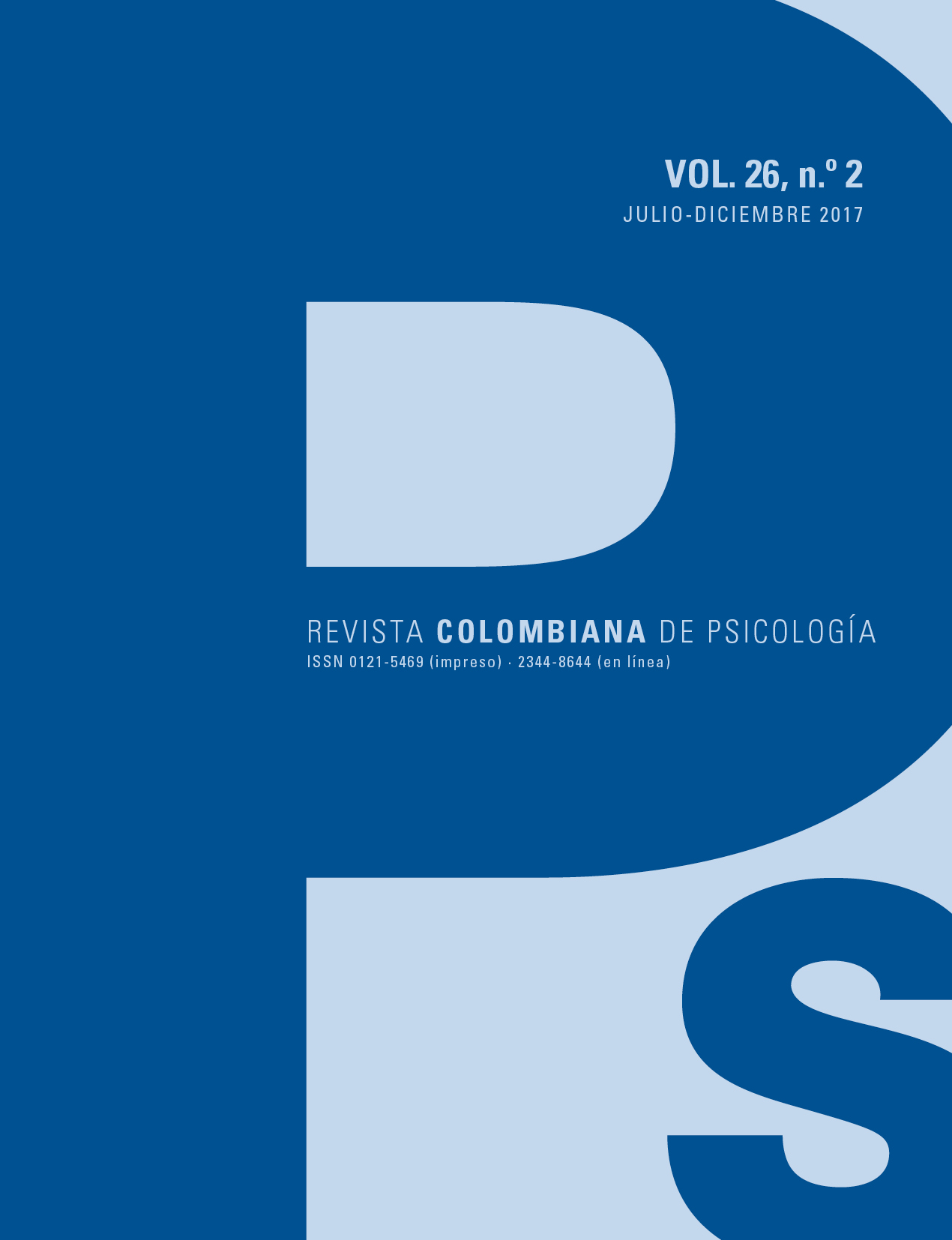El Yo como Construcción Intersubjetiva: lo que Enseña la Esquizofrenia
The Self as Intersubjective Construction: What Schizophrenia Teaches
DOI:
https://doi.org/10.15446/rcp.v26n2.57125Keywords:
fenomenología, esquizofrenia, yo experiencial, intersubjetividad (es)Downloads
Los análisis fenomenológicos de la esquizofrenia han mostrado que los síntomas característicos de esta enfermedad tienen que ver con una alteración profunda del sentido básico del yo. Este trabajo parte de la descripción de los trastornos de la intersubjetividad en la esquizofrenia. En dichas afecciones los sujetos esquizofrénicos viven el contacto interpersonal como una amenaza en la que su identidad puede ser usurpada. Se muestra cómo los análisis de algunos de los síntomas esquizofrénicos más agudos reafirman la posición defendida por la fenomenología de que el sentido experiencial del yo tiene una prioridad constitutiva fundamental.
Cómo citar este artículo: Cely, F. E. (2017). El yo como construcción intersubjetiva: lo que enseña la esquizofre- nia. Revista Colombiana de Psicología, 26(2), 207-217. doi: 10.15446/rcp.v26n2.57125
Phenomenological analyses of schizophrenia have shown that this disease’s characteristic symptoms involve a profound alteration of the basic sense of self. This work begins with the description of intersubjectivity disorders in schizophrenia. In these conditions, schizophrenic subjects live interpersonal contact as a threat that their identity can be stolen. The article shows how analysis of some of the most acute schizophrenic symptoms reaffirms phenomenology’s position that the experiential sense of self has a fundamental constitutive priority.
How to cite: Cely, F. E. (2017). The Self as Intersubjective Construction: What Schizophrenia Teaches. Revista Colombiana de Psicología, 26(2), 207-217. doi: 10.15446/rcp.v26n2.57125
References
Andreasen, N. C. (1983). The Scale for the Assessment of Negative Symptoms (sans). Iowa: University of Iowa.
Andreasen, N. C. (1984). The Scale for the Assessment of Positive Symptoms (saps). Iowa: University of Iowa.
Bråten, S. (2009). The intersubjective mirror in infant learning and evolution of speech. Amsterdam: John Benjamins Publishing Company.
Bruner, J. (1987). El self transaccional. En Realidad mental y mundo posibles: los actos de la imaginación que dan sentido a la experiencia (pp. 67-79). Barcelona: Gedisa.
Bruner, J. (2000). La construcción narrativa de la realidad. En La educación, puerta de la cultura (pp. 149-168). Madrid: Visor.
Cely, F. E. (2011). El yo como tema de análisis fenomenológico. Ideas y Valores, 146, 59-72.
Cely, F. E. (2014). Intersubjetividad: entre explicación y comprensión. Revista Colombiana de Psiquiatría, 43(1), 52-57.
Frith, C. D. (1992). The cognitive neuropsychology of schizophrenia. Hillsdale: Erlbaum.
Fuchs, T. (2010). Phenomenology and psychopathology. En S. Gallagher, S. & D. Schmicking (Eds.) Handbook of Phenomenology and Cognitive Science (pp. 547-574). Dordrecht: Springer.
Gallagher, S. (2001). The practice of mind: Theory, simulation, or interaction? Journal of Consciousness Studies, 8(5-7), 83-108.
Gallagher, S. & Zahavi, D. (2007). The phenomenological mind: An introduction to philosophy of mind and cognitive science. New York: Routledge.
Gopnik, A. & Meltzoff, A. N. (1997). Words, thoughts, and theories. Cambridge: MIT Press.
Hume, D. (1984). Tratado de la naturaleza humana. Barcelona: Orbis.
Husserl, E. (1950). Ideas relativas a una fenomenología pura y a una filosofía fenomenológica. México: Fondo de Cultura Económica.
Husserl, E. (1982). Investigaciones lógicas. Madrid: Alianza.
Husserl, E. (1986). Meditaciones cartesianas. México: Fondo de Cultura Económica.
Jaspers, K. (2014). Psicopatología general. México: Fondo de Cultura Económica.
Kant, I. (1998). Crítica de la razón pura. Trad. y Ed. de Pedro Ribas. Madrid: Alfaguara.
Lysaker, P. H., Johannesen, J. K., & Lysaker, J. T. (2005). Schizophrenia and the experience of intersubjectivity as threat. Phenomenology and the Cognitive Sciences,
(3), 335-352.
Mead, G. H. (1968). Espíritu, persona y sociedad. Desde el punto de vista del conductismo social. México: Paidós.
Parnas J. (2003). Self and schizophrenia: a phenomenological perspective. En T. Kircher & A. David (Eds.) The Self in Neuroscience and Psychiatry (pp. 217-241). Cambridge: Cambridge University Press.
Parnas, J. & Bovet, P. (1994). Negative/positive symptoms of schizophrenia: Clinical and conceptual issues. Nordic Journal of Psychiatry, 48(suppl. 31), 5-14.
Parnas, J. & D. Zahavi (2002). The role of phenomenology in psychiatric diagnosis and classification. En M. Maj et al. (Eds.), Psychiatric diagnosis and classification
(pp. 137-162). Chichester: John Wiley & Sons.
Pull, C. B. (2002). Diagnosis of schizophrenia: A review. En M. Maj & N. Sartorius (Eds.). Schizophrenia. WPA Series evidence and experience in psychiatry. Volume
(pp. 1-37) Chichester: John Wiley & Sons.
Ricoeur, P. (1996). Sí mismo como otro. México: Siglo XXI.
Rochat, P., Passos-Ferreira, C. & Salem, P. (2009). Three levels of intersubjectivity in early development. En A. Carassa, F. Morganti, & G. Riva (Eds.), Enacting intersubjectivity. Paving the way for a dialogue between cognitive science, social cognition and neuroscience. International Workshop (pp.173-190). Lugano: Università Svizzera Italiana.
Sass, L. (2003). Self-disturbance in schizophrenia: Hyperreflexivity and diminished self-affection. En T. Kircher & A. David (Eds.) The self in neuroscience and psychiatry (pp.242-271). Cambridge: Cambridge University Press.
Sass, L. (2010). Phenomenology as description and as explanation: The case of schizophrenia. En S. Gallagher, S. & D. Schmicking (Eds.) Handbook of phenomenology and cognitive science (pp. 635-654). Dordrecht: Springer.
Zahavi, D. (2005). Subjectivity and selfhood: Investigating the first-person perspective. Cambridge: MIT Press.
Zahavi, D. (2009). Is the self a social construct? Inquiry, 52 (6), 551-573.
How to Cite
APA
ACM
ACS
ABNT
Chicago
Harvard
IEEE
MLA
Turabian
Vancouver
Download Citation
License
Copyright (c) 2017 Revista Colombiana de PsicologíaThe RCP is published under the Creative Commons license and can be copied and reproduced according to the conditions of this license (http://creativecommons.org/licenses/by-nc-nd/2.5). RCP articles are available online at https://revistas.unal.edu.co/index.php/psicologia/issue/archive. If you would like to subscribe to the RCP as reader, please go to https://revistas.unal.edu.co/index.php/psicologia/information/readers and follow the instructions mentioned in the webpage. Additionally, a limited number of print journals are available upon request. To request print copies, please email revpsico_fchbog@unal.edu.co.


























